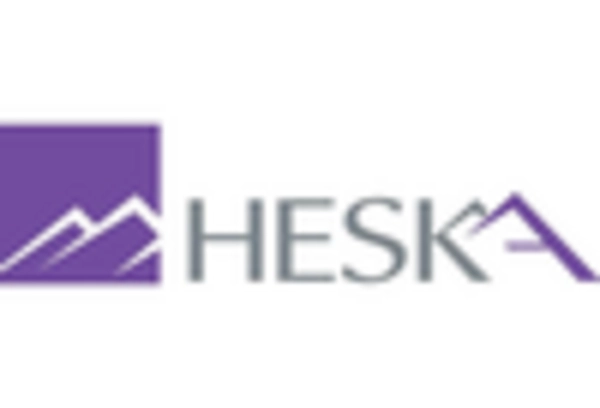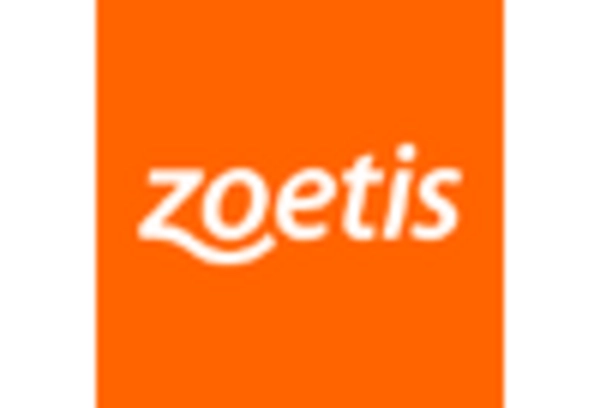Regulatory Support and Standards
The Swine Diagnostic Testing Market is benefiting from increased regulatory support and the establishment of stringent standards aimed at ensuring animal health and food safety. Governments and regulatory bodies are implementing policies that mandate regular testing for specific diseases, thereby driving demand for diagnostic services. For instance, regulations concerning the monitoring of swine diseases such as Porcine Reproductive and Respiratory Syndrome (PRRS) are becoming more rigorous. This regulatory landscape is expected to propel the market forward, as compliance with these standards necessitates the use of reliable diagnostic testing. Furthermore, the establishment of guidelines for biosecurity measures is likely to enhance the credibility of diagnostic services, fostering trust among producers. As a result, the Swine Diagnostic Testing Market is anticipated to expand in response to these regulatory developments, creating opportunities for innovation and growth.
Growing Awareness of Animal Health
There is a notable increase in awareness regarding animal health and welfare, which is significantly influencing the Swine Diagnostic Testing Market. Farmers and producers are becoming more cognizant of the impact that diseases can have on their livestock, leading to a heightened focus on preventive measures. This shift in mindset is reflected in the growing investment in diagnostic testing, as stakeholders recognize that early detection can mitigate losses and enhance productivity. Market data indicates that the demand for diagnostic services has risen by approximately 20% over the past few years, as producers seek to implement comprehensive health management programs. This trend is likely to continue, as education and outreach efforts promote the importance of regular testing and monitoring. Consequently, the Swine Diagnostic Testing Market is poised for sustained growth as more stakeholders prioritize animal health.
Increasing Global Pork Consumption
The rising The Swine Diagnostic Testing Industry. As pork remains a staple protein source in many regions, the demand for healthy and disease-free livestock is paramount. Market analysis suggests that pork consumption is projected to grow by approximately 10% over the next five years, which in turn necessitates robust health management practices. Producers are increasingly aware that maintaining herd health through effective diagnostic testing is essential to meet this rising demand. Consequently, there is a growing emphasis on implementing comprehensive testing protocols to ensure the quality and safety of pork products. This trend is likely to stimulate investments in diagnostic technologies and services, thereby propelling the Swine Diagnostic Testing Market forward. As the industry adapts to changing consumer preferences, the focus on health and safety will remain a critical factor.
Emerging Diseases and Biosecurity Concerns
The emergence of new diseases and ongoing biosecurity concerns are pivotal factors influencing the Swine Diagnostic Testing Market. As pathogens evolve and new threats arise, the need for effective diagnostic solutions becomes increasingly urgent. Recent outbreaks of diseases such as African Swine Fever (ASF) have underscored the vulnerabilities within swine populations, prompting producers to prioritize biosecurity measures. Market data indicates that investments in diagnostic testing are expected to rise by 25% in response to these challenges, as stakeholders seek to implement proactive health management strategies. This heightened focus on biosecurity is likely to drive demand for advanced diagnostic tools that can quickly identify and contain outbreaks. As a result, the Swine Diagnostic Testing Market is positioned to grow, as producers recognize the importance of safeguarding their herds against emerging threats.
Technological Innovations in Swine Diagnostic Testing
The Swine Diagnostic Testing Market is experiencing a surge in technological innovations that enhance the accuracy and speed of disease detection. Advanced molecular techniques, such as PCR and next-generation sequencing, are becoming increasingly prevalent. These technologies allow for the rapid identification of pathogens, which is crucial for effective disease management. According to recent data, the adoption of these advanced diagnostic tools is projected to increase by approximately 15% annually. This growth is driven by the need for timely interventions to prevent outbreaks, thereby safeguarding herd health and productivity. Furthermore, the integration of artificial intelligence in diagnostic processes is likely to streamline operations, making testing more efficient and cost-effective. As a result, stakeholders in the Swine Diagnostic Testing Market are increasingly investing in these innovations to stay competitive and meet the rising demand for precise diagnostic solutions.


















Leave a Comment